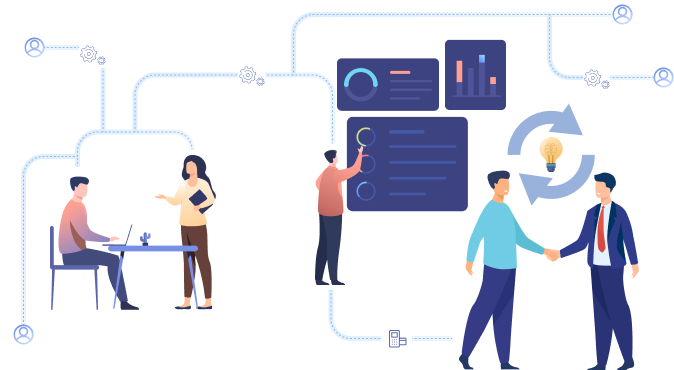Measuring Return on Data (ROD) for Enterprises
Measuring Return on Data (ROD) for Enterprises
Enterprise leaders are increasingly interested in understanding how effectively their enterprise drives and derives value from its data. Most enterprises already earmark a significant amount of capital for data collection, storage, processing, and transformation. I hear from several executives who remain concerned about the ROI on their capital investment, unable to draw a line from their investment in data and attributable business ROI.

Return on Data can often be hard to identify and quantify on a day-to-day basis. This is because most enterprises operate on several established, pre-defined processes and workflows. Employees are trained to perform their job functions through an established procedure, and workflows are established to double and triple check decisions and actions at each step. In these situations, value from data can only really effectively be materialized if it influences or forces minor and/or major changes in enterprise workflows and processes.
For executives interested in measuring the value from their data, we recommend that they follow a five-step process:
- Identify Business Workflows
- Determine information gaps
- Address information gaps
- Measure DAAU (Daily Analytics Average Usage)
- Identify NBPA (Next Best Predicted Action)
1. Identifying Business Workflows
The first step in the ability of an enterprise to measure extracted value from their data is to use historical and descriptive analytics to understand which of their business workflows are suffering. I have found that there are three universal mechanisms to measure the quality of a business workflow that directly correlate to the potential value of improving the workflow.

Manual Touchpoints
What is the total number of manual touchpoints in a business workflow i.e. the number of decisions or actions that require human intervention? Manual touchpoints typically require a decision to be made on part of the human. Typically, manual touchpoints are potential areas where errors are introduced in the workflows and these errors often generate negative business value.
Timeliness
What is the total end-to-end time required for one complete execution of the business workflow? Workflows that tend to take longer than desired or planned generate negative business value.
Accuracy
What is the percentage of workflow executions that do not have the desired impact?
Frequency
What are the business workflows that have the highest frequency of execution?
2. Measuring Potential Analytics Impact
Often, high-frequency business workflows with low accuracy, low timeliness, or a high number of manual touchpoints are ideal for value generation through augmented analytics. Measuring the frequency of a business workflow is critical as it magnifies the negative metrics of timeliness, accuracy and manual checkpoints for any business workflow. Executives can use the above analysis to determine the set of business workflows that are key contenders for refactoring and augmentation through analytics.
3. Determining and Addressing Information Gaps
Next, executives should determine how information, when delivered at the right time, in the right format and in right context can be used to increase the accuracy of decisions, the speed at which the decisions are made and the potential elimination of manual touchpoints. Executives can then leverage their data and reporting frameworks to generate and address the information gaps.

4. Measuring Daily Active Analytics Usage (DAAU)
Once the right information has been systematically injected into the desired business workflows, executives should track their Daily Active Analytics Usage, i.e. Are employees leveraging the curated information at the intended position in business workflows? A lagging indicator of high DAAU is usually an increase in the accuracy and timeliness of business workflows. A low DAAU typically indicates a training gap where employees are not comfortable with or unable to interpret the information accurately to make better decisions. Once training gaps have been addressed, low DAAU is usually a sign that the information is inaccurate or in the format where it is consumable for accurate decisions to be made.

After identifying and addressing information gaps, enterprises often realize that their business workflows are often archaic or overly complex. Such analysis and restricting of business workflows lead to the identification of areas of potential predictions and prescriptions that increase the likelihood of speedy, less error-prone, more accurate completion of business workflows.
5. Augmented Business Workflows with Next Best Predicted Action (NBPA)
Business workflows can be fundamentally reshaped and restructured to drive down latency, inaccuracy, and errors by introducing NBPA – Next Best Prediction Action. This is the action or decision an intelligent system prescribes at a given point in a workflow delivered to the employee in the ideal format and structure. The NBPA leverages ML trained over historical data and observation of past actions and decisions and offers an augmented decisioning experience for the employee. The NBPA offers a “second opinion” to the employee that enables them to make better decisions. By enabling an “Accept” or “Reject” control on the NBPA, enterprises can ensure that the system learns and improves rapidly over time.

DAAU & NBPA
Through the combination of DAAU and NBPA, executives can ensure that their capital investment in data leads to more demonstrable and sustainable ROI for their enterprise. Instead of separate IT and Business initiatives, this framework ensures that investment in data and analytics is by design, intended to not only identify areas of potential value but deliver concrete ROI through the application of information in business-critical workflows.






